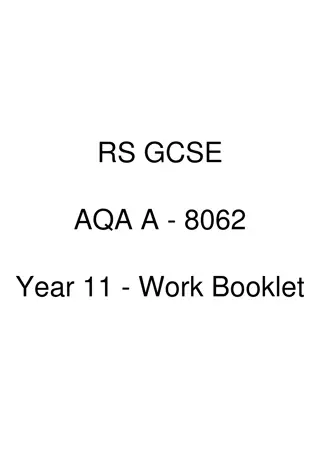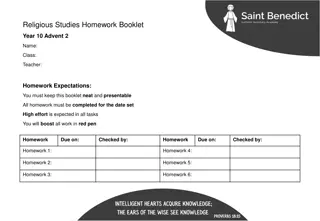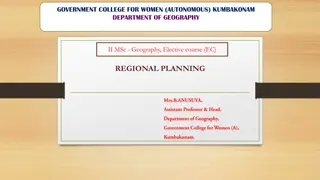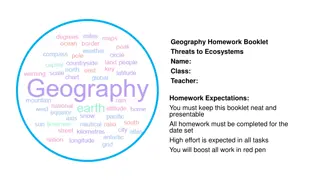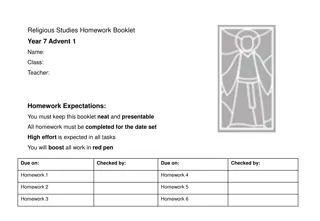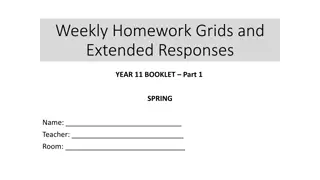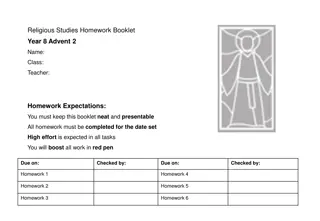Geography Year 9 Summer Homework Booklet
This Geography Year 9 Summer Homework Booklet covers topics such as Global Biomes, Location and Climate, and Brazil's Tropical Rainforests. Students are expected to define key terms, study maps, answer questions, and label countries to demonstrate their knowledge and understanding of various geographical concepts. High effort and neat presentation are required for completion. Red pen must be used for corrections.
Download Presentation

Please find below an Image/Link to download the presentation.
The content on the website is provided AS IS for your information and personal use only. It may not be sold, licensed, or shared on other websites without obtaining consent from the author.If you encounter any issues during the download, it is possible that the publisher has removed the file from their server.
You are allowed to download the files provided on this website for personal or commercial use, subject to the condition that they are used lawfully. All files are the property of their respective owners.
The content on the website is provided AS IS for your information and personal use only. It may not be sold, licensed, or shared on other websites without obtaining consent from the author.
E N D
Presentation Transcript
Geography Homework Booklet Year 9 Summer 1 Name: Class: Teacher: Homework Expectations: You must keep this booklet neat and presentable All homework must be completed for the date set High effort is expected in all tasks You will boost all work in red pen
Year 9 Weekly Homework Summer 1.1 Global Biomes Knowledge Book P50- 52 1a. Define the following key terms: 2. Study the map on P37 Describe the distribution of the world s biomes [4]: _________________________________________________ _________________________________________________ _________________________________________________ _________________________________________________ _________________________________________________ _________________________________________________ _________________________________________________ _________________________________________________ _________________________________________________ _________________________________________________ _________________________________________________ Biome- _____________________________________________________________________ Climate- ____________________________________________________________________ ____________________________________________________________________________ 1b. List 3 biotic (living) components in an ecosystem: 1c. List 3 abiotic (non-living) components in an ecosystem: 3. Decide if the following statements are TRUE or FALSE: 4. Label these countries on the diagram: UK a) Antarctica is the world s largest desert ____________ Egypt b) The main biomes of the UK are Mountainous and Tundra ____________ Greenland c) Tropical Rainforest biome is found along the equator ____________ Brazil Canada d) Northern Africa is mainly Desert and Savannah biome ____________ e) Savannah Grasslands experience all 4 seasons ____________ f) Deciduous woodlands are considered an extreme environment ____________
Year 9 Weekly Homework Summer 1.2 Location and Climate Knowledge Book P50, P53, P59 1. Study the Penang Climate graph on P53 - Draw the missing data onto the graph below: 3. Fill in the key terms and definitions for the following, using P50: Key Term Definition Ecosystem Climate A climate of hot temperatures and rainfall for only half the year. A climate of hot and humid conditions all year round. 2. Use P53. Answer these questions about Penang s climate: 4. Explain two characteristic of the Semi-arid Grassland biome: One characteristic of this biome is _________________________________________ a) Identify the wettest month. ___________________________________________ _____________________________________________________________________ b) How hot is the highest temperature? ___________________________________ This means that ______________________________________________________ _____________________________________________________________________ c) Which month(s) have the coldest temperature? ___________________________ _____________________________________________________________________ d) TRUE or FALSE: There are no cold months in Penang? ____________________ Another characteristic of this biome is ______________________________________ e) Which is the driest month in Penang? __________________________________ _____________________________________________________________________ This means that ______________________________________________________ f) Approx. How much rainfall, falls in September? ___________________________ _____________________________________________________________________ g) What is the average temperature in Penang? _____________________________ _____________________________________________________________________
Year 9 Weekly Homework Summer 1.3 Brazils Tropical Rainforests Knowledge Book P53-54 1. Use the axis to draw and label the 4 different layers of the tropical rainforest: 3. Study the map. Describe the location of the Amazon Rainforest in South America [4]: 50m 40m 30m 20m 10m 2. Answer the following questions about the climate of the Tropical Rainforest: a) Which month receives the least rainfall? ____________________________________________________________________________ b) Which month received the most rainfall? ____________________________________________________________________________ c) TRUE or FALSE: There are no cold months in Penang, Malaysia ____________________________________________________________________________ ____________________________________________________________________________ d) What month has the highest temperature? ____________________________________________________________________________ e) TRUE or FALSE: Penang, Malaysia receives very little rainfall ____________________________________________________________________________ f) How many millimetres of rain fall in Septemeber? ____________________________________________________________________________ ____________________________________________________________________________ g) TRUE or FALSE: Penang, Malaysia has a hot, humid climate. ____________________________________________________________________________
Year 9 Weekly Homework Summer 1.4 Tropical Rainforest Food Chains and Adaptations Knowledge Book P50, 55-56 1. Use P35 to find a key term/ definition to complete the table. Then use P41 to provide an example from the Tropical Rainforest to complete the food chain in the final column. 3. Research an animal that lives in the Tropical Rainforest. In the space below, draw a picture of that animal, then underneath, describe how it is specifically adapted to survive: Key Term Definition Example Producer Orchid Animals that eat vegetation (producers). These are usually herbivores. Secondary Consumer Found: Status: Eat primary and secondary consumers as their main source of food. They are the top of the food chain. Adaptations: 2. 4. Use P40, describe the following plant adaptations and draw a picture: ____________________________________________________________ ____________________________________________________________ ____________________________________________________________ ____________________________________________________________ ____________________________________________________________ ____________________________________________________________ ____________________________________________________________ ____________________________________________________________ ____________________________________________________________ ____________________________________________________________ ____________________________________________________________ ____________________________________________________________ Adaptation Description of Adaptation Drawing of Adaptation Drip Tip Leaves Buttress Roots Lianas
Year 9 Weekly Homework Summer 1.5 Semi-Arid Grasslands Knowledge Book P50, P59 1. Define the following key terms: rainforest: 3. Study the map. Describe the location of the world s semi-arid grasslands [4]: Semi-Arid Climate- _____________________________________________________________ _____________________________________________________________________________ Xerophytic- ___________________________________________________________________ _____________________________________________________________________________ Ecosystem- ___________________________________________________________________ _____________________________________________________________________________ 2. Answer the following questions about the climate of semi-arid grasslands: _____________________________________________________________________ a) Which month in the Serengeti receives the most rainfall? _____________________________________________________________________ b) Which month in Zinder receives the most rainfall? _____________________________________________________________________ _____________________________________________________________________ c) TRUE or FALSE: There are no cold months in Zinder or the Serengeti? _____________________________________________________________________ d) What month in Zinder has the highest temperature? _____________________________________________________________________ e) TRUE or FALSE: The Serengeti has a wet season and a dry season? _____________________________________________________________________ f) How many millimetres of rain fall in April in the Serengeti? _____________________________________________________________________ g) TRUE or FALSE: Zinder s dry season is between May and October? _____________________________________________________________________
Year 9 Weekly Homework Summer 1.6 Semi-Arid Grassland Food Chains and Adaptations Knowledge Book P50, 60-62 1. Use P35 to find a key term/ definition to complete the table. 3. Use P45 and P46. Around each tree, label all the different adaptations: Key Term Definition Leaves that have fallen to the ground and are decomposing. Biomass Decomposers Acacia Tree When a plant or animal adjusts or changes to suit its environment. 2. 4. Use P47 to draw out an label a food chain from the semi-arid grassland: _______________ _______________ _______________ Acacia Tree Producer ______________ ______________ ______________ ______________ ______________ ______________ Baobab Tree
Questions to ask: ___________________________ ___________________________ ___________________________ ___________________________ ___________________________ ___________________________ ___________________________ ___________________________ ___________________________ ___________________________ ___________________________ ___________________________ ___________________________ ___________________________ ___________________________ ___________________________ ___________________________ Notes: ___________________________ ___________________________ ___________________________ ___________________________ ___________________________ ___________________________ ___________________________ ___________________________ ___________________________ ___________________________ ___________________________ ___________________________ ___________________________ ___________________________ ___________________________ ___________________________ ___________________________
Questions to ask: ___________________________ ___________________________ ___________________________ ___________________________ ___________________________ ___________________________ ___________________________ ___________________________ ___________________________ ___________________________ ___________________________ ___________________________ ___________________________ ___________________________ ___________________________ ___________________________ ___________________________ Notes: ___________________________ ___________________________ ___________________________ ___________________________ ___________________________ ___________________________ ___________________________ ___________________________ ___________________________ ___________________________ ___________________________ ___________________________ ___________________________ ___________________________ ___________________________ ___________________________ ___________________________
Questions to ask: ___________________________ ___________________________ ___________________________ ___________________________ ___________________________ ___________________________ ___________________________ ___________________________ ___________________________ ___________________________ ___________________________ ___________________________ ___________________________ ___________________________ ___________________________ ___________________________ ___________________________ Notes: ___________________________ ___________________________ ___________________________ ___________________________ ___________________________ ___________________________ ___________________________ ___________________________ ___________________________ ___________________________ ___________________________ ___________________________ ___________________________ ___________________________ ___________________________ ___________________________ ___________________________
Questions to ask: ___________________________ ___________________________ ___________________________ ___________________________ ___________________________ ___________________________ ___________________________ ___________________________ ___________________________ ___________________________ ___________________________ ___________________________ ___________________________ ___________________________ ___________________________ ___________________________ ___________________________ Notes: ___________________________ ___________________________ ___________________________ ___________________________ ___________________________ ___________________________ ___________________________ ___________________________ ___________________________ ___________________________ ___________________________ ___________________________ ___________________________ ___________________________ ___________________________ ___________________________ ___________________________








